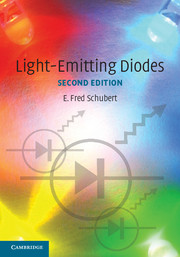Book contents
- Frontmatter
- Contents
- Preface
- 1 History of light-emitting diodes
- 2 Radiative and non-radiative recombination
- 3 Theory of radiative recombination
- 4 LED basics: Electrical properties
- 5 LED basics: Optical properties
- 6 Junction and carrier temperatures
- 7 High internal efficiency designs
- 8 Design of current flow
- 9 High extraction efficiency structures
- 10 Reflectors
- 11 Packaging
- 12 Visible-spectrum LEDs
- 13 The AlGaInN material system and ultraviolet emitters
- 14 Spontaneous emission from resonant cavities
- 15 Resonant-cavity light-emitting diodes
- 16 Human eye sensitivity and photometric qualities
- 17 Colorimetry
- 18 Planckian sources and color temperature
- 19 Color mixing and color rendering
- 20 White-light sources based on LEDs
- 21 White-light sources based on wavelength converters
- 22 Optical communication
- 23 Communication LEDs
- 24 LED modulation characteristics
- Appendix 1 Frequently used symbols
- Appendix 2 Physical constants
- Appendix 3 Room temperature properties of III–V arsenides
- Appendix 4 Room temperature properties of III–V nitrides
- Appendix 5 Room temperature properties of III–V phosphides
- Appendix 6 Room temperature properties of Si and Ge
- Appendix 7 Periodic system of elements (basic version)
- Appendix 8 Periodic system of elements (detailed version)
- Index
20 - White-light sources based on LEDs
Published online by Cambridge University Press: 05 September 2012
- Frontmatter
- Contents
- Preface
- 1 History of light-emitting diodes
- 2 Radiative and non-radiative recombination
- 3 Theory of radiative recombination
- 4 LED basics: Electrical properties
- 5 LED basics: Optical properties
- 6 Junction and carrier temperatures
- 7 High internal efficiency designs
- 8 Design of current flow
- 9 High extraction efficiency structures
- 10 Reflectors
- 11 Packaging
- 12 Visible-spectrum LEDs
- 13 The AlGaInN material system and ultraviolet emitters
- 14 Spontaneous emission from resonant cavities
- 15 Resonant-cavity light-emitting diodes
- 16 Human eye sensitivity and photometric qualities
- 17 Colorimetry
- 18 Planckian sources and color temperature
- 19 Color mixing and color rendering
- 20 White-light sources based on LEDs
- 21 White-light sources based on wavelength converters
- 22 Optical communication
- 23 Communication LEDs
- 24 LED modulation characteristics
- Appendix 1 Frequently used symbols
- Appendix 2 Physical constants
- Appendix 3 Room temperature properties of III–V arsenides
- Appendix 4 Room temperature properties of III–V nitrides
- Appendix 5 Room temperature properties of III–V phosphides
- Appendix 6 Room temperature properties of Si and Ge
- Appendix 7 Periodic system of elements (basic version)
- Appendix 8 Periodic system of elements (detailed version)
- Index
Summary
As the trend of higher efficiencies in LEDs continues, the number of possible applications increases as well. A highly interesting application with a very large potential market size is general daylight illumination in homes and offices. The field of solid-state lighting (SSL) is concerned with the development of solid-state sources for illumination applications. LEDs are inherently monochromatic emitters. However, there are several ways to generate white light using LEDs. Approaches to white-light generation based on LEDs will be covered in the current chapter, whereas approaches based on LEDs and wavelength-converting materials will be discussed in the following chapter. A pivotal discussion of the promise of solid-state lighting was given by Bergh et al. (2001). A comprehensive introduction to lighting technology using solid state sources was given by Zukauskas et al. (2002a).
In the field of general daylight illumination, devices should have the following properties (i) high efficiency, (ii) high power capability, (iii) good color-rendering capabilities (iv) high reliability, (v) low-cost manufacturability, and (vi) environmental benignity. Such properties would allow LEDs to compete with conventional illumination sources, in particular incandescent and fluorescent lamps.
Generation of white light with LEDs
Light is perceived as white light if the three types of cones located on the retina of the human eye are excited in a certain ratio, namely with similar intensity. For the case of white light, the tristimulus values are such that the location of the chromaticity point is near the center of the chromaticity diagram.
- Type
- Chapter
- Information
- Light-Emitting Diodes , pp. 332 - 345Publisher: Cambridge University PressPrint publication year: 2006
- 5
- Cited by

